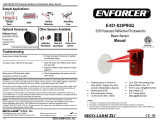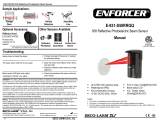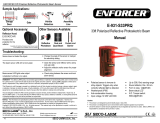Page is loading ...

ENFORCER 35ft Retro-Reflective Photoelectric Beam Sensor
4 SECO-LARM U.S.A., Inc.
WARRANTY:
This SECO
-
LARM
product is warranted against defects in material and workmanship while
used in normal
service for 1 (one) year from the date of sale to the original customer. SECO-LARM’s obligation is limited to the repair or
replacement of any defective part if the unit is returned, transportation prepaid, to SECO-LARM. This Warranty is void if
damage is caused by or attributed to acts of God, physical or electrical misuse or abuse, neglect, repair or alteration,
improper or abnormal usage, or faulty installation, or if for any other reason SECO-LARM determines that such equipment
is not operating properly as a result of causes other than defects in material and workmanship. The sole obligation of
SECO-LARM and the purchaser’s exclusive remedy, shall be limited to the replacement or repair only, at SECO-LARM’s
option. In no event shall SECO-LARM be liable for any special, collateral, incidental, or consequential personal or property
damage of any kind to the purchaser or anyone else.
SECO
-
LARM
®
U.S.A., Inc.
16842 Mil
likan Avenue, Irvine, CA 92606
Website: www.seco
-
larm.com
Phone: (949) 261
-
2999 | (800) 662
-
0800
Email: sales@seco
-
larm.com
NOTICE
:
The SECO
-
LARM policy is one of continual development and improvement.
For
that reason, SECO
-
LARM
reserves the right to change specifications without notice. SECO-LARM is also not responsible for misprints.
Copyright © 2016 SECO-LARM U.S.A., Inc. All rights reserved. This material may not be reproduced or copied, in whole or
in part, without the written permission of
SECO
-
LARM.
®
PITJW3
MI_E
-
936
-
S35RRGQ_160912.docx
Sensor does not detect the object.
• Change the angle of the sensor or readjust the sensitivity setting
Yellow LED does not turn on
• Clean the sensor and reflector with a damp (not wet) cloth
• Adjust the reflector and/or sensor for proper alignment
LEDs turn off when object is
detected, but no output
• No continuity between sensor and alarm device. Check cable from
sensor to alarm device. Test sensor.
Troubleshooting:
Optional Accessories Available from
SECO
-
LARM
®
:
E-931ACC-R2Q
Square Reflector
E-931ACC-RC1Q
Round Reflector
E
-
931ACC
-
HR1Q
Reflector Hood for
Round/Square Reflector
E-931ACC-BLR2Q
Reflector Bracket
E
-
931ACC
-
BLS1Q
Sensor Bracket
E
-
931ACC
-
BLS7Q
Wall Bracket
E
-
931ACC
-
BLS8Q
Door Frame Bracket
E
-
931ACC
-
BLS6Q
Single-gang Bracket
Sample Installations:
Garage Door
Main Entrance Door
Store Entrance
Parking Distance Monitor
Entry Gate
Caution:
• This sensor was not designed to prevent bodily injury or loss of life.
• This sensor was not designed for use in environments where explosive gases may be present.
• Use of this sensor in certain security applications may be regulated by local laws or codes. SECO-LARM
is not responsible for compliance with such laws or codes.
E-936-S35RRGQ
35ft Retro-Reflective Photoelectric Beam Sensor
Manual
Features:
• Up to 35ft (11m) sensing range
• Weatherproof (IP66) construction for
indoor/outdoor usage
• Pre-wired 6-foot cord
• Bracket and mounting hardware included
for both sensor and reflector
• Adjustable sensing range
• Compact size
Typical Applications:
• Sensor for garage doors or outdoor gates
• Entry detection for store fronts
• Assist in measuring parking distance
• Light on type
IMPORTANT: The E-936-S35RRGQ conforms
to UL325-2016 for gate operators that use the
N.C. or 10kΩ resistor for monitoring.
•

ENFORCER 35ft Retro-Reflective Photoelectric Beam Sensor
2 SECO-LARM U.S.A., Inc.
Dimensions:
Reflector
Transmitter/Receiver
2
15
/
32
″
(63mm)
3
/
16
″
(5mm)
1
9
/
16
″
(40mm)
2
5
/
16
″
(58mm)
1
13
/
16
″
(30mm)
13
/
16
″
(20mm)
2
5
/
8
″
(66mm)
13
/
16
″
(20mm)
19
/
32
″
(15.1mm)
3
/
8
″ (10mm)
2
1
/
32
″
(52mm)
2
1
/
16
″
(53mm)
6
1
/
2
′ (2m) cable
1
/
4
″ (6mm) diameter
3
/
16
″ (4.5mm) thru holes
Parts List:
1x
Transmitter/Receiver
1x
Reflector
4
x
Lock Washers
4
x
Hex Nuts
1x
Sensor Mounting Bracket
1
x
Reflector Mounting Bracket
4
x
Flat Washers
1
x
Manual
2
x
Sensor Mounting Screws
2
x
Reflector Mounting Screws
Mounting the Sensor:
Wiring:
Note:
1.
Can be connected to AC or DC voltage
2.
Maximum cable extension length is
325 ft (100 m)
Connection (5 wires)
Brown
12
-
30V DC
24~30V AC (60Hz), 83mA
(Non-polarized)
Blue
Gray (N.O.)
White (COM)
Black (N.C.)
Multi
-
voltage
circuit
Relay
Output
10kΩ
Type
Retro
-
reflective
Sensing range
0.5~
3
5
ft (0.2~
1
1
m)
Operating voltage
12
-
30
V
DC
/
24
-
30V
AC
60Hz
,
83
mA
Current draw
Standby
6
0
mA@12VDC
Active
25
mA@12VDC
Response time
10ms
(max.)
Light source
IR LED
LED indicators
Yellow LED (a
lignment), Red LED (
power
on
,
trigger
ed
off
)
Trigger output
SPDT Relay output
(NO/NC/COM, with built-in 10KΩ resistor on N.O. output)
Switching capacity
2A@30VAC/VD
C
Enclosure
IP
66 Weatherproof
Operating temperature
-
4
°
~131°
F (
-
20
°
~55°
C)
Mounting brackets for sensor
and reflector
Included
Specifications:
ENFORCER 35ft Retro-Reflective Photoelectric Beam Sensor
SECO-LARM U.S.A., Inc. 3
LED Functions:
• Red LED – When ON, indicates the sensor is powered
and the sensor is not triggered.
• Yellow LED – When ON, indicates the sensor is properly
aligned with the reflector and the sensor is not triggered.
Sensing Range Adjustment Functions:
• Min. Setting – The infrared power signal emitted by the
sensor is at its minimum or weakest.
• Max. Setting – The infrared power signal emitted by the
sensor is at its maximum or strongest.
The purpose of this function is to adjust the infrared signal's
power to correspond to the distance between the sensor
and the reflector. The factory default setting is set at “Max.”
Note: If the infrared signal is too strong, the sensor may not
trigger. If the infrared signal is too weak, the sensor
may be susceptible to false alarms.
Installation:
1. Mount the reflector and the sensor so they face each
other (see pg. 2, "Mounting the Sensor").
2. Connect power to the sensor (see pg. 2, "Wiring"). The
red LED (power) should turn ON. If the yellow LED is
ON, the sensor and reflector are aligned (although
some adjustment may still be necessary).
3. Turn the sensing range knob to Max.
4. To find the corre
ct alignment, slowly adjust the angles of
the sensor (and/or reflector) up, down, left or right.
Note: Correct alignment is reached when the yellow LED
turns ON.
Note:
If adjusting the sensor will not turn the yellow LED on,
the sensor is at the edge of sensing the signal, and
may not work properly.
Adjusting the Sensing Range:
After the sensor and reflector have been properly installed,
the next step is to adjust the sensor range (See Fig. 1).
Starting from the Max. position, slowly turn the knob
counter-clockwise until the yellow LED turns OFF. This
position represents the weakest point of the infrared signal
Max
Min
Fig. 1
Red LED
Yellow LED
Sensing
Range Knob
for this particular application. The setting of the sensing
range must be a little higher than this point, so turn the knob
clockwise somewhat from the weakest point. The ideal
setting is midway between the weakest point and Max.
Note: When turning the knob counter-clockwise from the
Max. position, if the weak point is near the Max.
position then the knob should be set at Max.
Testing:
1. Power up the sensor. Both LEDs should be ON.
2. Pass the object to be detected between the sensor and
reflector. Both LEDs should turn OFF. This indicates
that the object has been detected.
Note: If a shiny object, such as a chrome-plated item or
something with reflective tape, is within close
proximity of the path of the IR beam, the sensor may
not be able to detect the passing object. It may be
necessary to turn the sensing range knob counter-
clockwise until the desired setting is obtained.
Note:
Dependi
ng on the monitoring system used by the
gate motor, it may be necessary to use either the
N.C. output or the built-in 10kΩ resistor on the N.O.
output. Please refer to the gate operator manual or
the gate operator manufacturer for the preferred
monitoring method.
The E-936-S35RRGQ will not work with gate
operators that monitor using the "heartbeat" method.
Installation and Adjustment:
Mounting the Reflector:
Examples
of
Fixed Mounting
Examples for
Vertically
Adjusting the
Mounting
Examples for
Horizontally
Adjusting
the
Mounting
/







